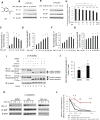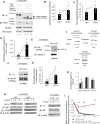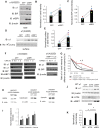Remodeling the endoplasmic reticulum proteostasis network restores proteostasis of pathogenic GABAA receptors
- PMID: 30481215
- PMCID: PMC6258528
- DOI: 10.1371/journal.pone.0207948
Remodeling the endoplasmic reticulum proteostasis network restores proteostasis of pathogenic GABAA receptors
Abstract
Biogenesis of membrane proteins is controlled by the protein homeostasis (proteostasis) network. We have been focusing on protein quality control of γ-aminobutyric acid type A (GABAA) receptors, the major inhibitory neurotransmitter-gated ion channels in mammalian central nervous system. Proteostasis deficiency in GABAA receptors causes loss of their surface expression and thus function on the plasma membrane, leading to epilepsy and other neurological diseases. One well-characterized example is the A322D mutation in the α1 subunit that causes its extensive misfolding and expedited degradation in the endoplasmic reticulum (ER), resulting in autosomal dominant juvenile myoclonic epilepsy. We aimed to correct misfolding of the α1(A322D) subunits in the ER as an approach to restore their functional surface expression. Here, we showed that application of BIX, a specific, potent ER resident HSP70 family protein BiP activator, significantly increases the surface expression of the mutant receptors in human HEK293T cells and neuronal SH-SY5Y cells. BIX attenuates the degradation of α1(A322D) and enhances their forward trafficking and function. Furthermore, because BiP is one major target of the two unfolded protein response (UPR) pathways: ATF6 and IRE1, we continued to demonstrate that modest activations of the ATF6 pathway and IRE1 pathway genetically enhance the plasma membrane trafficking of the α1(A322D) protein in HEK293T cells. Our results underlie the potential of regulating the ER proteostasis network to correct loss-of-function protein conformational diseases.
Conflict of interest statement
The authors have declared that no competing interests exist.
Figures






Similar articles
-
Combining valosin-containing protein (VCP) inhibition and suberanilohydroxamic acid (SAHA) treatment additively enhances the folding, trafficking, and function of epilepsy-associated γ-aminobutyric acid, type A (GABAA) receptors.J Biol Chem. 2015 Jan 2;290(1):325-37. doi: 10.1074/jbc.M114.580324. Epub 2014 Nov 18. J Biol Chem. 2015. PMID: 25406314 Free PMC article.
-
L-type Calcium Channel Blockers Enhance Trafficking and Function of Epilepsy-associated α1(D219N) Subunits of GABA(A) Receptors.ACS Chem Biol. 2015 Sep 18;10(9):2135-48. doi: 10.1021/acschembio.5b00479. Epub 2015 Jul 21. ACS Chem Biol. 2015. PMID: 26168288
-
SAHA enhances Proteostasis of epilepsy-associated α1(A322D)β2γ2 GABA(A) receptors.Chem Biol. 2013 Dec 19;20(12):1456-68. doi: 10.1016/j.chembiol.2013.09.020. Epub 2013 Nov 7. Chem Biol. 2013. PMID: 24211135 Free PMC article.
-
Proteostasis regulation of GABAA receptors in neuronal function and disease.Biomed Pharmacother. 2025 May;186:117992. doi: 10.1016/j.biopha.2025.117992. Epub 2025 Mar 20. Biomed Pharmacother. 2025. PMID: 40112516 Free PMC article. Review.
-
Targeting unfolded protein response signaling pathways to ameliorate protein misfolding diseases.Curr Opin Chem Biol. 2013 Jun;17(3):346-52. doi: 10.1016/j.cbpa.2013.04.009. Epub 2013 May 4. Curr Opin Chem Biol. 2013. PMID: 23647985 Free PMC article. Review.
Cited by
-
Proteostasis Regulators Restore Function of Epilepsy-Associated GABAA Receptors.Cell Chem Biol. 2021 Jan 21;28(1):46-59.e7. doi: 10.1016/j.chembiol.2020.08.012. Epub 2020 Sep 3. Cell Chem Biol. 2021. PMID: 32888501 Free PMC article.
-
Monitoring the Secretion and Activity of Alpha-1 Antitrypsin in Various Mammalian Cell Types.Methods Mol Biol. 2024;2750:143-163. doi: 10.1007/978-1-0716-3605-3_14. Methods Mol Biol. 2024. PMID: 38108975 Free PMC article.
-
Missense variants in GABAA receptor beta2 subunit disrupt receptor biogenesis and cause loss of function.bioRxiv [Preprint]. 2025 Mar 10:2025.03.09.642292. doi: 10.1101/2025.03.09.642292. bioRxiv. 2025. PMID: 40161784 Free PMC article. Preprint.
-
Intermittent hypoxia: linkage between OSAS and epilepsy.Front Pharmacol. 2023 Nov 23;14:1230313. doi: 10.3389/fphar.2023.1230313. eCollection 2023. Front Pharmacol. 2023. PMID: 38074156 Free PMC article. Review.
-
Pharmacological Analysis of GABAA Receptor and Sigma1R Chaperone Interaction: Research Report I-Investigation of the Anxiolytic, Anticonvulsant and Hypnotic Effects of Allosteric GABAA Receptors' Ligands.Int J Mol Sci. 2023 May 31;24(11):9580. doi: 10.3390/ijms24119580. Int J Mol Sci. 2023. PMID: 37298532 Free PMC article.
References
-
- Brodsky JL, Skach WR (2011) Protein folding and quality control in the endoplasmic reticulum: Recent lessons from yeast and mammalian cell systems. Curr Opin Cell Biol 23: 464–475. 10.1016/j.ceb.2011.05.004 - DOI - PMC - PubMed
-
- Feige MJ, Hendershot LM (2013) Quality control of integral membrane proteins by assembly-dependent membrane integration. Mol Cell 51: 297–309. 10.1016/j.molcel.2013.07.013 - DOI - PMC - PubMed
-
- Jefferson RE, Min D, Corin K, Wang JY, Bowie JU (2018) Applications of Single-Molecule Methods to Membrane Protein Folding Studies. J Mol Biol 430: 424–437. 10.1016/j.jmb.2017.05.021 - DOI - PMC - PubMed
-
- Olzmann JA, Kopito RR, Christianson JC (2013) The mammalian endoplasmic reticulum-associated degradation system. Cold Spring Harb Perspect Biol 5: a013185 10.1101/cshperspect.a013185 - DOI - PMC - PubMed
Publication types
MeSH terms
Substances
Grants and funding
LinkOut - more resources
Full Text Sources
Other Literature Sources
Research Materials

